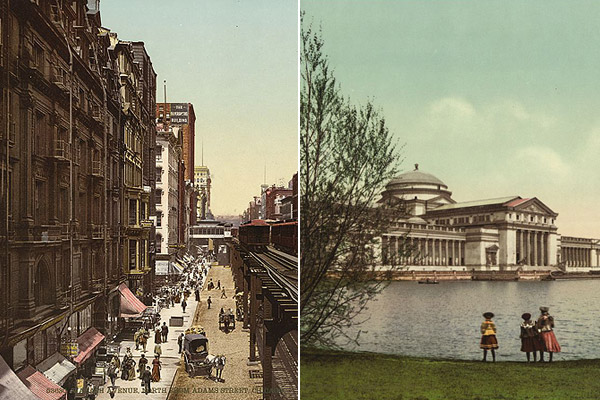
One of my favorite troves of early Chicago ephemera is the massive Detroit Publishing Company archive, which captures the city as it established itself as the capital of the Midwest and one of the industrial centers of the world; here's an extensive gallery of the city on the make, as it was being made. Nonetheless, it's still in black and white, giving Chicago an austere beauty but not depicting the city as its residents would have known it.
In the early 1890s, color photography was in its infancy; in the next decade, it was possible but impractical and expensive. The common man could view spectacular Kromograms, but the viewer (sort of like a Viewmaster) cost $50 in 1907 (PDF), the equivalent of about $1100 today; Kromograms were about $25 in 2011 dollars. But some of the Detroit Publishing Company's negatives made their way to Switzerland, where they were converted into color prints through an elaborate process known as photocrom:
A Photochrom is a color photo lithograph, produced from a black-and-white negative. The final prints were created using different color impressions from multiple lithographic stones. The stones used by the Detroit Photographic Company were imported from Bavaria and coated with a special Syrian 'asphaltum' substance that would be chemically sensitized to light, put in contact with a photographic negative, exposed to the sun for up to several hours, then "developed" in oils of turpentine.
The areas of the very thin asphalt gel most exposed to light would harden, becoming insoluble; the less exposed residue would be washed away. Tonal values of the remaining positive image could be manipulated by varying the chemistry and development times. Technicians could do the equivalent of burning and dodging by retouching the brush and polishing with fine pumice powder. The final steps in preparing the stone were an acid etch to bond the remaining image with its very fine grain, and a glycerin bath.
A separate stone would be made for each color to be used. A minimum of four stones and as many as fourteen stones might be used for a given image. A transparent ink would be applied to the stone, then transferred to high-quality paper whose texture resembled the smooth photographic printing paper of the day.
Around the same time, the U.S. Post Office relinquished its monopoly on postcards—prior to 1878 they existed, but only the post office could make them—and an industry was born. The Detroit Publishing Company and the Swiss Photoglob Company made some seven million a year of tens of thousands of views, and in doing so gave many their first full-color glimpses of far-away places. One of those was Chicago (via the Library of Congress).
[See also: "Marshall Field, the First PR Man, and a Civil War Vet Create an Epic Transportation Travelogue."]


